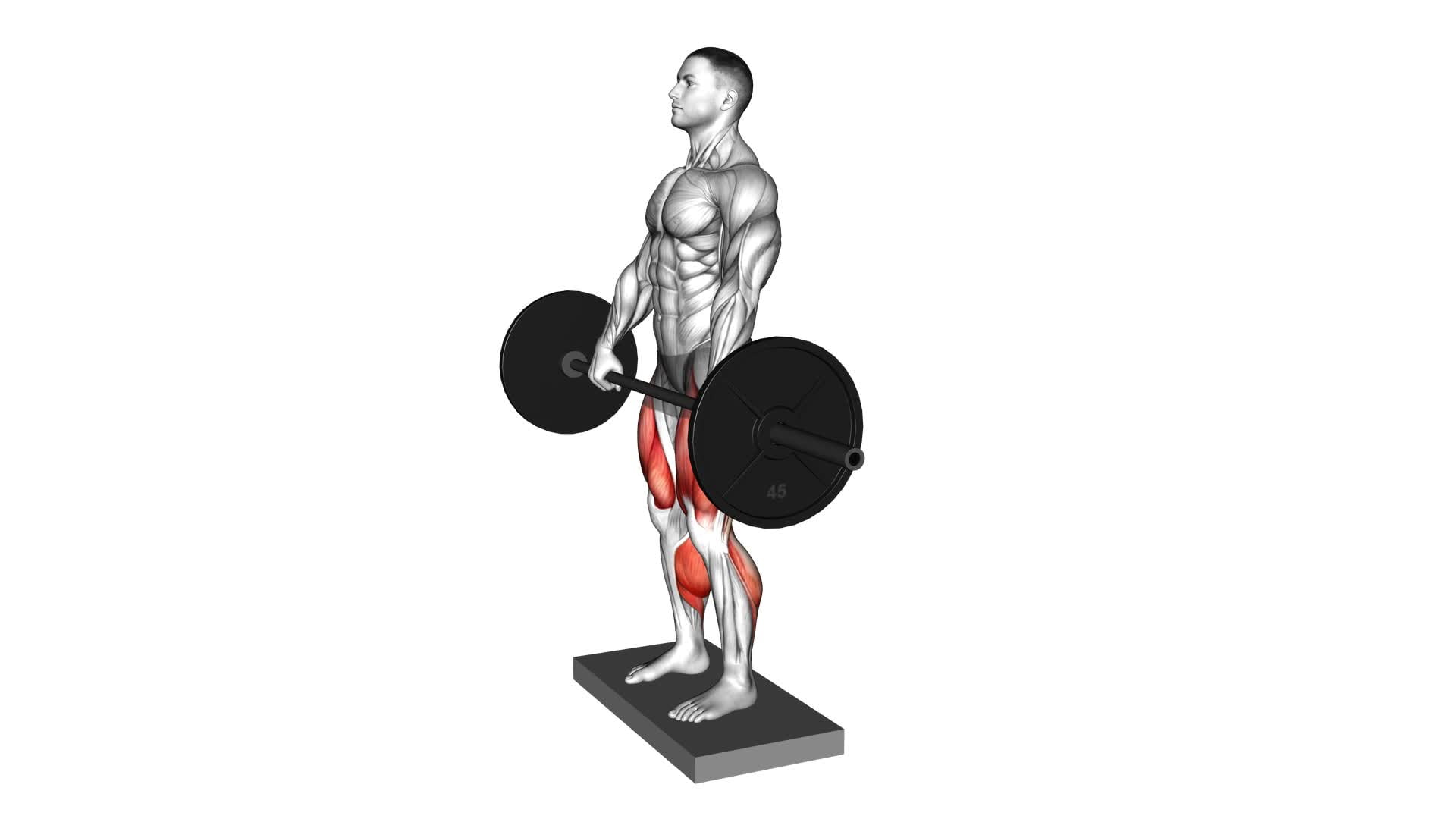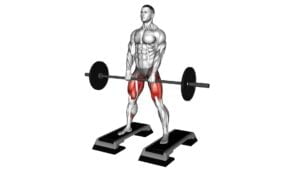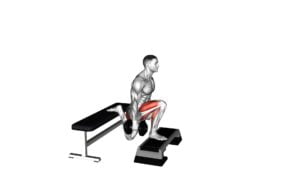Barbell Deadlift From Deficit – Video Exercise Guide & Tips

Looking to take your deadlift to the next level? Want to strengthen your posterior chain and improve your overall strength and power? Look no further than the Barbell Deadlift From Deficit.
Watch This Exercise Video
In this video exercise guide, we'll show you the proper set-up and form for this challenging variation. We'll also provide tips to avoid common mistakes and offer progressions and variations to keep you challenged.
Get ready to elevate your deadlift game with this effective exercise!
Key Takeaways
- The barbell deadlift from deficit increases activation in the hamstrings, glutes, and lower back.
- Performing the exercise from a deficit allows for a deeper stretch in the muscles, leading to greater muscle activation and development.
- The exercise places more emphasis on the posterior chain, improving lower body strength and stability.
- While the exercise offers benefits, individuals with pre-existing joint or back issues should be cautious due to the increased stress on joints and risk of injury.
Benefits of the Barbell Deadlift From Deficit
When performing the barbell deadlift from a deficit, you'll experience increased activation in your hamstrings, glutes, and lower back due to the greater range of motion. This exercise is advantageous for several reasons.
Firstly, the increased range of motion allows for a deeper stretch in the muscles, leading to greater muscle activation and development. This can result in improved strength and power in these muscle groups.
Additionally, the deficit deadlift places more emphasis on the posterior chain, which includes the hamstrings, glutes, and lower back. This can help to improve overall lower body strength and stability.
Moreover, the deficit deadlift can also enhance your grip strength, as you'll have to hold the barbell for a longer distance.
On the other hand, it's important to be aware of the potential disadvantages of this exercise. The greater range of motion can place more stress on your joints, particularly the knees and lower back. It's crucial to maintain proper form and technique to minimize the risk of injury.
Furthermore, individuals with pre-existing joint or back issues should exercise caution when performing the deficit deadlift.
Equipment Needed for the Barbell Deadlift From Deficit
To properly perform the barbell deadlift from a deficit, you'll need the following equipment:
- Barbell: This exercise requires a standard barbell, which is a long metal bar with weights on either end. The barbell should be sturdy and able to support the weight you plan to lift.
- Weight Plates: You'll need weight plates to add resistance to the barbell. Start with lighter weights and gradually increase as you get stronger and more comfortable with the exercise. Make sure the weight plates you choose are compatible with your barbell.
- Deficit Platform: To perform the barbell deadlift from a deficit, you'll need a platform or step to stand on. This will increase the range of motion and make the exercise more challenging. You can use a specially designed deficit platform or simply stack weight plates or blocks to create the desired height.
- Lifting Straps (Optional): While not necessary, lifting straps can be beneficial for maintaining your grip on the barbell. This can be especially helpful when lifting heavier weights or if your grip strength is a limiting factor.
Having the right equipment is essential for performing the barbell deadlift from a deficit safely and effectively. Make sure you have all the necessary items before attempting this exercise to maximize its benefits and variations.
Proper Set-Up and Form for the Barbell Deadlift From Deficit
To properly set up and execute the barbell deadlift from a deficit, focus on maintaining a strong and stable position for optimal performance.
Start by standing with your feet shoulder-width apart, toes pointing slightly outwards. Position the barbell on the floor in front of you, just beyond your toes.
Bend at the hips and knees, keeping your back straight and chest up, to grip the barbell with an overhand grip, hands slightly wider than shoulder-width apart. Engage your core and brace your abs as you lift the barbell off the ground, extending your hips and knees until you're standing upright.
Throughout the movement, keep your back straight, shoulders back, and chest lifted. Avoid rounding your back or allowing your knees to cave in.
There are variations and progressions you can incorporate into your barbell deadlift from deficit routine. You can use different deficit heights, such as standing on weight plates or blocks, to increase the range of motion and challenge your strength.
Additionally, you can try using different grips, such as a mixed grip or a hook grip, to vary the muscle activation and increase grip strength. It's important to gradually progress in weight and difficulty to avoid overexertion and injury.
By following these proper set-up and form guidelines, you can perform the barbell deadlift from a deficit effectively and safely.
Now let's move on to discussing common mistakes to avoid during the barbell deadlift from deficit.
Common Mistakes to Avoid During the Barbell Deadlift From Deficit
One common mistake to avoid during the barbell deadlift from deficit is rounding your back. Maintaining proper form is crucial to prevent injury and maximize the effectiveness of this exercise. Here are four technique tips to help you avoid common mistakes:
- Engage your core: Before lifting the barbell, brace your core by contracting your abdominal muscles. This helps stabilize your spine and maintain a neutral back position throughout the movement.
- Keep your shoulders back: Pull your shoulder blades down and back, creating tension in your upper back. This helps maintain a stable and upright posture during the lift.
- Push through your heels: As you lift the barbell, focus on driving through your heels. This helps activate your glutes and hamstrings, ensuring they bear the brunt of the load rather than your lower back.
- Avoid jerking or rounding your back: Maintain a smooth and controlled motion throughout the exercise. Avoid any sudden movements or rounding of your back, as this puts excessive stress on your spine and increases the risk of injury.
Progressions and Variations for the Barbell Deadlift From Deficit
Now let's explore how you can progress and vary your training with the barbell deadlift from deficit. There are several variations and progressions you can incorporate into your routine to challenge your muscles and continue making gains.
One variation is the sumo deadlift from deficit. This variation involves taking a wider stance and gripping the barbell inside your legs. By widening your stance, you engage different muscle groups, such as the inner thighs and glutes, while still targeting your posterior chain.
Another variation is the snatch grip deadlift from deficit. This variation involves gripping the bar with a wider grip, similar to the grip used in the snatch exercise. This wider grip increases the range of motion and places more emphasis on the upper back and shoulders.
To progress in your training, you can gradually increase the height of the deficit. Start with a small deficit, such as using weight plates or a step platform, and gradually increase the height over time. This progression challenges your muscles to adapt to the increased range of motion and builds strength in your posterior chain.
Remember to always prioritize proper form and technique when performing these variations and progressions. Start with lighter weights and gradually increase the load as you become more comfortable and confident with the movements.
Tips for Incorporating the Barbell Deadlift From Deficit Into Your Workout Routine
When incorporating the barbell deadlift from deficit into your workout routine, it's important to focus on proper form techniques to maximize the effectiveness of the exercise.
This includes maintaining a neutral spine, engaging your core, and keeping your shoulders back and down.
The barbell deadlift from deficit primarily targets the muscles in your lower body, including your hamstrings, glutes, and quadriceps.
Proper Form Techniques
You can incorporate the barbell deadlift from deficit into your workout routine by focusing on proper form techniques. To ensure you're performing the exercise correctly and safely, follow these tips:
- Benefits of proper form techniques:
- Reduced risk of injury: By maintaining proper form, you minimize the strain on your lower back and other muscles, reducing the risk of injury.
- Increased muscle activation: Proper form ensures that the targeted muscles, such as the glutes, hamstrings, and lower back, are effectively engaged, maximizing muscle activation and growth.
- Common mistakes in proper form techniques:
- Rounded back: Avoid rounding your back, as it places excessive stress on the spine.
- Overarching the lower back: Hyperextending your lower back can lead to strain and discomfort.
- Using momentum: Don't rely on momentum to lift the weight; focus on using your muscles to perform the movement.
- Neglecting proper breathing: Remember to breathe properly throughout the exercise to maintain stability and control.
Muscle Groups Targeted
To effectively target multiple muscle groups and incorporate the barbell deadlift from deficit into your workout routine, focus on proper form techniques.
This exercise primarily activates the muscles in your lower body, including your glutes, hamstrings, and quadriceps. The deficit aspect of the lift also increases the range of motion, further engaging these muscles.
Additionally, the deadlift from deficit also works your core muscles, including your abs and lower back, as they help stabilize your body throughout the movement.
To modify the exercise, you can start with a lower deficit or use lighter weights until you're comfortable with the movement. As you progress, you can increase the deficit or add more weight to challenge yourself.
Remember to always prioritize form and listen to your body to avoid injury.
Frequently Asked Questions
How Does the Barbell Deadlift From Deficit Differ From a Regular Barbell Deadlift?
The barbell deadlift from deficit differs from a regular barbell deadlift in a few key ways.
By standing on an elevated platform, such as weight plates or a box, you increase the range of motion and make the exercise more challenging.
This targets your muscles differently, particularly your hamstrings and glutes.
The benefits include improved strength, muscle development, and stability.
It's a great variation to incorporate into your training routine for added difficulty and results.
Can the Barbell Deadlift From Deficit Help Improve Grip Strength?
The barbell deadlift from deficit can definitely help improve your grip strength. By increasing the distance the barbell has to travel, this exercise puts more demand on your grip.
Additionally, you can incorporate grip exercises into your workout routine to further enhance your grip strength. Using grip trainers, such as grip strengtheners or grip balls, can provide additional benefits.
These exercises can be easily added to your routine and will help you develop a stronger grip.
What Are Some Alternative Exercises That Can Be Used as Progressions or Variations to the Barbell Deadlift From Deficit?
Looking for alternative progressions or variations to the barbell deadlift from deficit?
There are a few options you can try.
One is the Romanian deadlift, which focuses on the hamstrings and glutes.
Another is the sumo deadlift, which targets the inner thighs and glutes.
Lastly, you can try single-leg deadlifts to challenge your balance and stability.
These exercises can help you strengthen different muscle groups and add variety to your workout routine.
Are There Any Specific Warm-Up Exercises or Stretches That Should Be Done Before Attempting the Barbell Deadlift From Deficit?
Before attempting the barbell deadlift from deficit, it's important to warm up and stretch properly.
Specific warm-up exercises can include bodyweight squats, lunges, and hip mobility exercises to loosen up your lower body.
As for stretches, focus on your hamstrings, hip flexors, and lower back with movements like standing forward bends and seated butterfly stretches.
Additionally, to improve grip strength for the barbell deadlift from deficit, try using a thicker bar or incorporating exercises like farmer's walks and towel pull-ups into your training routine.
How Often Should the Barbell Deadlift From Deficit Be Incorporated Into a Workout Routine for Optimal Results?
To incorporate the barbell deadlift from deficit into your workout routine effectively, you need to consider the benefits it offers.
This exercise targets your lower body and core muscles, helping to improve strength and stability.
For optimal results, aim to incorporate the barbell deadlift from deficit into your routine at least once or twice a week.
Remember to start with lighter weights and gradually increase the load as you become more comfortable and proficient with the exercise.
Conclusion
Incorporating the barbell deadlift from a deficit into your workout routine can offer numerous benefits, including increased strength and muscle development. This exercise targets the posterior chain and can help improve your overall lifting technique.
By following proper form and avoiding common mistakes, you can maximize the effectiveness of this exercise. Remember to start with lighter weights and gradually progress to more challenging variations.
Make sure to consult with a fitness professional if you have any concerns or questions.

Author
Years ago, the spark of my life’s passion ignited in my mind the moment I stepped into the local gym for the first time. The inaugural bead of perspiration, the initial endeavor, the very first surge of endorphins, and a sense of pride that washed over me post-workout marked the beginning of my deep-seated interest in strength sports, fitness, and sports nutrition. This very curiosity blossomed rapidly into a profound fascination, propelling me to earn a Master’s degree in Physical Education from the Academy of Physical Education in Krakow, followed by a Sports Manager diploma from the Jagiellonian University. My journey of growth led me to gain more specialized qualifications, such as being a certified personal trainer with a focus on sports dietetics, a lifeguard, and an instructor for wellness and corrective gymnastics. Theoretical knowledge paired seamlessly with practical experience, reinforcing my belief that the transformation of individuals under my guidance was also a reflection of my personal growth. This belief holds true even today. Each day, I strive to push the boundaries and explore new realms. These realms gently elevate me to greater heights. The unique combination of passion for my field and the continuous quest for growth fuels my drive to break new ground.







